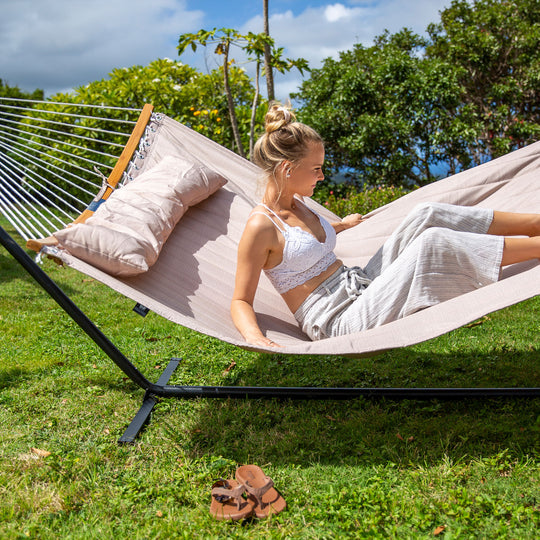SUNCREAT - Sept. 17th 2024
Can You Leave a Hammock Outside All Year Round
Hammocks have become a beloved addition to many backyards, patios, and outdoor spaces. With their promise of comfort and relaxation, they offer a perfect escape on a sunny summer afternoon or a crisp fall evening. As more people embrace outdoor living, hammocks have helped bridge the gap between indoor comfort and outdoor leisure, encouraging people to step outside, enjoy nature, and unwind. However, with hammocks becoming a regular part of our lives, a practical question arises: Can you leave your hammock outside all year round?
This question revolves around the weather resistance and durability of both the hammock frame and the fabric. Let's explore these factors in detail.
The Hammock Frame: Durability in Changing Weather
One of the most important aspects to consider when determining whether your hammock can remain outside year-round is the material of the frame. Typically, hammock frames are made from either metal or wood, each with its own set of advantages and challenges when exposed to the elements.
Metal Frames
Metal hammock frames, especially those made from stainless steel or powder-coated steel, are known for their excellent resistance to rust and weather damage. These materials are specifically designed to handle moisture and withstand the elements. This means they perform well in most outdoor climates, resisting rain and humidity.
However, even the most resilient metals are not entirely immune to the effects of prolonged exposure. Over time, constant exposure to rain, snow, and sunlight can lead to corrosion or degradation, even in stainless steel. To prevent this, it is recommended to take a few precautions. One effective way to protect metal frames is by covering them with a weatherproof cover when the hammock is not in use. A simple cover can significantly extend the life of your metal frame, preventing water and UV damage.
Wooden Frames
Wooden hammock frames, while visually appealing and often adding a natural touch to your outdoor space, are much more susceptible to weather-related wear and tear. Many wood frames are treated to resist moisture, but despite this, wood is still prone to cracking, warping, or rotting after prolonged exposure to rain, snow, and sunlight.
If you choose a wooden frame, extra care is essential. Bringing the frame indoors during the winter or periods of heavy rain can help prevent long-term damage. Alternatively, you can invest in a protective cover specifically designed for outdoor wooden furniture. Regular maintenance, such as applying wood sealant or wax, will also keep the wood in good condition and extend its lifespan. By taking these steps, you can help your wooden frame survive the elements while retaining its aesthetic appeal.
The Hammock Fabric: Choosing Weather-Resistant Materials
The material of the hammock bed itself is another crucial factor in determining whether it can be left outside all year. The three most common hammock fabrics are cotton, nylon, and polyester, each with varying degrees of weather resistance.
Cotton Hammocks
Cotton hammocks are favored for their softness and comfort, making them perfect for a cozy afternoon nap. However, cotton is highly absorbent and not weather-resistant. When exposed to rain, it can easily soak up water, leading to mildew, mold, and eventual degradation of the fabric. Additionally, continuous exposure to UV rays can cause the fibers to weaken, fade, or even tear over time.
If you have a cotton hammock, it is not ideal to leave it outside year-round, especially in wet or humid climates. Storing it indoors during rainy seasons or when not in use is a smart move. This will protect the fabric and maintain its longevity.
Nylon and Polyester Hammocks
Nylon and polyester hammocks, on the other hand, are much more suited for outdoor use. These synthetic materials are known for their resistance to moisture and quick-drying properties, which make them excellent choices for outdoor environments. Nylon and polyester hammocks can withstand rain and humidity without absorbing water, and they dry quickly after a downpour.
However, even these durable fabrics are not invincible. Long-term exposure to sunlight can cause both nylon and polyester to fade and weaken over time. The UV rays can break down the fibers, leading to a loss of color and a decrease in overall fabric strength. To mitigate this, it is recommended to store these hammocks indoors when not in use for extended periods or to use a UV-protective cover.
Extending the Lifespan of Your Hammock
The ultimate answer to whether you can leave your hammock outside year-round depends on the materials and the level of care you are willing to provide. For metal frames and synthetic fabrics like nylon and polyester, outdoor durability is achievable with some thoughtful protection. Metal frames benefit from protective covers and occasional cleaning to remove moisture buildup, while nylon and polyester hammock beds can handle the elements with proper care.
For wooden frames and cotton hammocks, extra precautions are needed. Regular maintenance, such as sealing or waxing the wood and storing cotton fabrics indoors during inclement weather, will help keep your hammock in good shape.
Even if your hammock is made from weather-resistant materials, it is still a good idea to bring it indoors or cover it during extreme weather conditions. Heavy snow, storms, or prolonged wet weather can accelerate the wear and tear on any outdoor furniture, hammocks included.
In summary, while it is possible to leave a hammock outside all year round, it largely depends on the materials used for both the frame and the fabric. Metal frames and synthetic fabrics, with some level of protection, can withstand the elements reasonably well. However, even the most weather-resistant hammocks benefit from regular care and occasional indoor storage to extend their lifespan. For wooden frames and cotton hammocks, taking extra precautions is essential to prevent damage from the weather.
By understanding the strengths and weaknesses of different materials and implementing some simple protective measures, you can ensure that your hammock remains a relaxing retreat for years to come, no matter the season.







